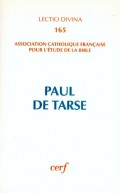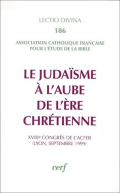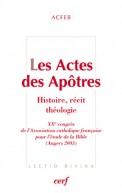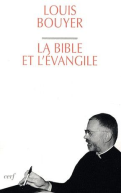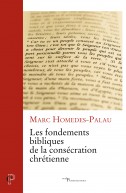
Comment la Bible saisit-elle l'histoire ?
d' ACFEB
Collection Lectio Divina - N° 215
304 pages - févr. 2007
33,00€
--
Jean-Michel Poffet, prefacer of this book, quotes Father Lagrange, the man who founded the École biblique de Jérusalem at the end of the 19th century. The latter wrote: ‘There is a certain way of writing history which is not our way, but which we find in the Old Testament.’ This is the challenge taken up by the biblists of the ACFEB during their 21st congress: to understand how the Bible sets down history. At the end of this book, J.-M. Carrière sums up what several contributions have revealed: there is not, so to speak, one Biblical historiography; but several historiographic projects that traverse the Old Testament. They are characterised by three features. 1) The biblical authors have a dual reference: they belong to a certain historical context, but when they write, they construct a ‘world’ that will be a reference for generations to come. 2) The times during which the historiographic elaboration took place were years of grave crises, even situations of finality: to write was to thwart death. 3) The writing down of history maintains a rapport with temporality rather than with causality: here, the chronology of events is not the objective, but their intelligent treatment – i.e. to reveal the meaning. We can observe the difference between this and our modern requisites in matters of historiography. Thus, the task was to understand the specific historian procedure for Biblical texts.
- Dimensions : 135x215x20
- ISBN : 9782204083263
- Poids : 385 grammes
Avec la collaboration de : Anne-Marie Pelletier, Christoph Theobald, Daniel Doré, François Brossier, Jacques Briend, Jean Louis Ska, Jean-Daniel Macchi, Jean-Marie Carrière, Jean-Michel Poffet, Marie-Françoise Baslez, Thomas Römer
DU MÊME AUTEUR
Le Judaïsme à l'aube de l'ère chrétienne
XVIIIe congrès de l'ACFEB (Lyon, septembre 1999)
d' ACFEB
416 pages - mars 2001
Nouvelles voies de l'exégèse (Les) - LD 190
En lisant le Cantique des cantiques
d' ACFEB
384 pages - avril 2002
> VOIR TOUS LES LIVRES DE l'AUTEUR
DANS LA CATÉGORIE EXÉGÈSE BIBLIQUE
À la recherche de la Parole - LD 207
Études d'exégèse et de théologie biblique
de Jacques Schlosser
608 pages - sept. 2006
La Bible et l'Évangile
Le sens de l'Écriture : du Dieu qui parle au Dieu fait homme
de Louis Bouyer
278 pages - févr. 2009
Comment tuer Jésus ? (poche)
Abus, violences et emprises dans la Bible
de Philippe Lefebvre
280 pages - oct. 2023

